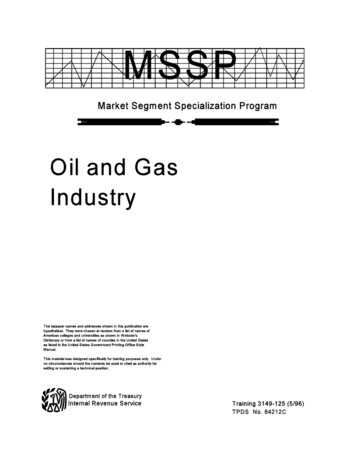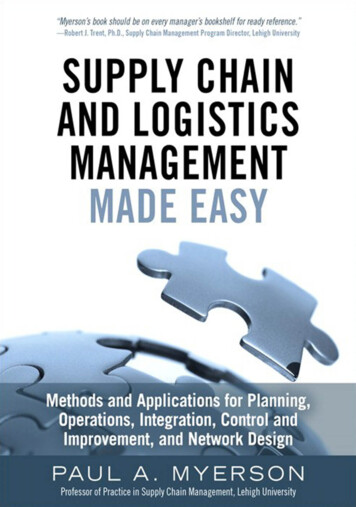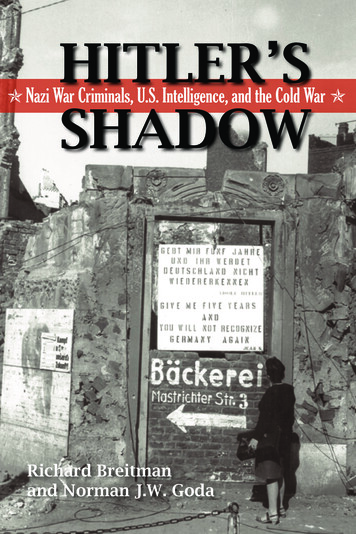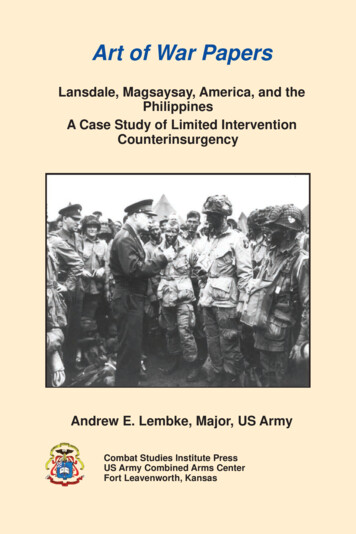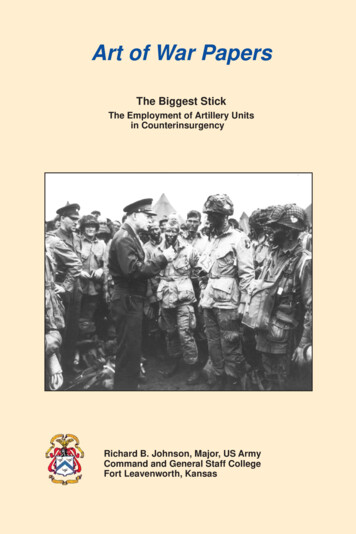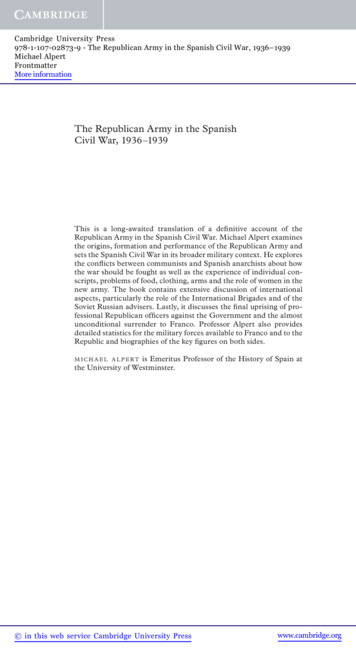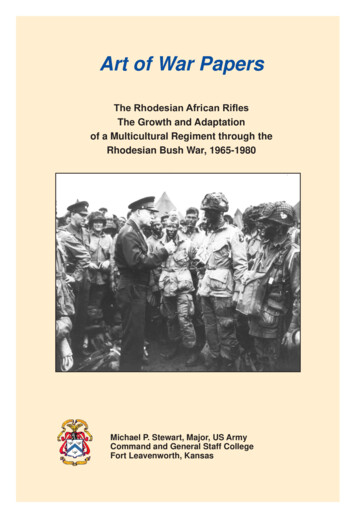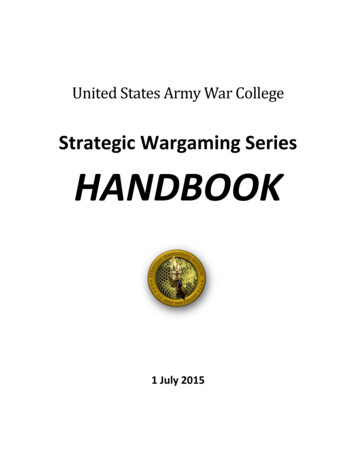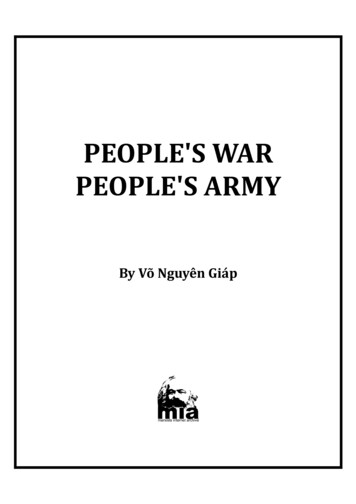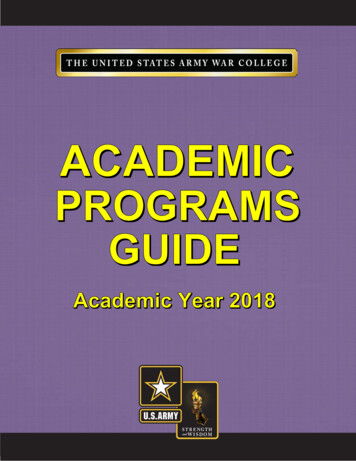
Transcription
INTENTIONALLY LEFT BLANK
Table of ContentsPart I: Introduction to the U.S. Army War College . 1Historical Perspective . 1Mission . 4Commandant’s Vision and Intent . 4Institutional Learning Outcome . 4Program Learning Objectives, Military Education Level 1 (MEL 1) Resident and DistanceEducation Programs . 5Program Learning Outcomes, Other Educational Programs . 6Basic Strategic Art Program (BSAP) . 6Nominative Leaders Course (NLC) . 7Senior Leader Seminar (SLS) . 7Army Strategic Education Program-Basic Course (ASEP-B) .8Combined Joint Force Land Component Commander Course (C/JFLCC) . 8Joint Service Reserve Component Officers Course (JSRCOC). 9Army Strategic Education Program-Advanced Course (ASEP-A) . 9Army Strategic Education Program-Senior Course (ASEP-S) .9Educational Philosophy . 10Enduring Themes . 11Professional Military Education (PME) . 12Joint Professional Military Education (JPME) . 12Accreditation . 12Part II: Admissions Policies . 14Military . 14Civilians . 15Department of the Army Civilians . 15Department of Defense (DOD) Civilians. 15Non-DOD Civilians . 15Commandant Invitations to Civilians . 16International Fellows. 16Commandant’s Diploma Program . 16Fellowship Programs . 16USAWC Fellows Program . 16Chief of Staff of the Army Senior Fellowship Program . 17Service Obligation . 17Part III: Academic Policies and Procedures . 18Master of Strategic Studies Degree (MSS), Resident and Distance Education Programs.18Acceptance of Transfer Credits . 18Graduation Requirements—Resident Education Program . 18Graduation Requirements—Distance Education Program . 19Academic Standards . 19Academic Integrity . 20Non-attribution . 20Academic Freedom . 20i
Attire . 21Physical Fitness . 21Seminar Learning Model . 21Faculty Advising and Feedback . 22Evaluation . 22Student Awards Program . 23Distinguished Graduates . 23Academic Records . 23Part IV: Academic Program . 24Resident Education Program. 24International Fellows Orientation . 24International Fellows English Language Academic Preparatory Course (APC) .24Core Courses. 24AA2200: Introduction to Strategic Studies . 24NS2200: Theory of War and Strategy (TWS) .25LM2201: Strategic Leadership (SL) . 25NS2201: National Security Policy and Strategy (NSPS) . 25WF2200: Theater Strategy and Campaigning (TSC) .25LM2202: Defense Management (DM) . 26NS2202-07 and NS2249: Regional Studies Program (RSP). 26IF2200: IF Unified Command Course (IF UCC) . 26AA2206: Strategy Research Project (SRP) . 26Strategic Studies Capstone: . 26Comprehensive Oral Examination . 27National Security Staff Rides (NSSR) . 27Annual Strategy Conference . 27National Security Seminar (NSS). 27Elective Courses . 28Special or Complementary Programs . 28Advanced Strategic Art Program (ASAP) . 28Carlisle Scholars Program (CSP) . 28National Security Policy Program (NSPP) . 28Advanced Defense Management Course (ADM) .29Joint Warfighting Advanced Studies Program (JWASP) .29Joint Land, Air, and Sea Strategic Special Program (JLASS-SP) . 29Eisenhower Series College Program . 30The Writing Enhancement Program . 30Commandant’s Lecture Series (CLS) . 30Noontime Lectures (NTL) . 30Military History Program . 31Strategic Leadership Feedback Program . 31Resident Curriculum – Class of 2018 . 32Distance Education Program . 33Courses . 33DE2300: Orientation . 33DE2301: Strategic Leadership (SL) . 33DE2302: National Security Policy and Strategy (NSPS) .34ii
DE2303: War and Military Strategy . 34DE2304: Regional Issues and Interests. 34DE2306: First Resident Course (FRC): Strategic Leadership in a GlobalEnvironment.34DE2307: Contemporary Security Issues (CSI) . 35DE2308: DOD Organization and Processes . 35DE2309: Theater Strategy Campaigning I .35DE2310: Theater Strategy Campaigning II .35DE2312: Second Resident Course (SRC): Strategic Leadership in Current andFuture Warfare .35Commandant’s National Security Program (CNSP) . 36Elective Courses . 36DE2344: Program Research Project (PRP) . 36DE2345: Personal Experience Monograph (PEM) . 36DE2346: Directed Study in Peace Operations, Stability Operations, or IrregularWarfare . 36Educational Trips/Staff Rides . 37National Security Staff Ride . 37Antietam Staff Ride . 37Gettysburg Staff Ride . 37Distance Education Program — Class 2018 . 37Other Educational Offerings . 38Basic Strategic Art Program (BSAP) . 38Nominative Leader Course (NLC) . 38Senior Leader Seminar (SLS) .38Army Strategic Education Program - Basic Course (ASEP-B) . 38Combined/Joint Forces Land Component Commander Course (C/JFLCC) . 39Joint Senior Reserve Component Officer Course (JSRCOC) . 39Army Strategic Education Program – Advanced Course (ASEP-A) . 39Army Strategic Education Program – Senior Course (ASEP-S) . 39Army Strategic Education Program – Transition Course (ASEP-T) .40Strategic Leader Staff Ride (SLSR) Program . 40Defense Strategy Course (DSC) . 40Defense Planners Course (DPC) . 40Defense Strategy Foundation Course (DSFC) . 41International Security Conflict Negotiation Course (ISCNE) . 41Part V: Departments, Centers, and Institutes . 42The School of Strategic Landpower (SSL) . 42Department of Command, Leadership, and Management (DCLM) . 42Department of Distance Education (DDE) . 42Department of Military Strategy, Planning, and Operations (DMSPO) . 42Department of National Security and Strategy (DNSS) . 43Strategic Studies Institute (SSI) and USAWC Press . 43Center for Strategic Leadership (CSL) . 44Department of Senior Leader Development (DSLD) . 44Department of Strategic Wargaming (DSW) .44Department of Technology Integration (DTI) . 45iii
Human Dimension Department (HDD) . 45U.S. Army Peacekeeping and Stability Operations Institute (PKSOI) . 45U.S. Army Heritage and Education Center (USAHEC) . 46U.S. Army Strategic Education Program (ASEP) .46Part VI: Student Body and Student Life . 48Student Profile . 48Class Organization . 48What to Expect . 49Carlisle Experience . 49Student Housing . 50On-post Shopping, Restaurant, and Child Facilities . 50Medical Support . 50Religious Services . 51Morale, Welfare, and Recreation Activities.51Carlisle Community . 51Part VII: Organization and Governance . 52USAWC Senior Leadership and Staff . 52USAWC Board of Visitors (BOV) . 55School of Strategic Landpower (SSL) . 56Department of Command, Leadership, and Management (DCLM) . 56Department of Distance Education (DDE) . 58Department of Military Strategy, Planning, and Operations (DMSPO) . 62Department of National Security and Strategy (DNSS) . 65Strategic Studies Institute (SSI). 67Center for Strategic Leadership (CSL) . 69Peacekeeping and Stability Operations Institute (PKSOI) . 72U.S. Army Heritage and Education Center (USAHEC) . 74U.S. Army Strategic Education Program (ASEP) . 75iv
Part I: Introduction to the U.S. Army War CollegeHistorical Perspective1General Order 155 established the USAWC on27 November 1901. The Secretary of War, Elihu Root,laid the cornerstone for Roosevelt Hall, the War Collegebuilding, at Washington Barracks (now Fort McNair) on21 February 1903. In his dedication speech, Rootchallenged the USAWC “to preserve peace by intelligentand adequate preparation to repel aggression, throughstudying and conferring on the great problems of nationaldefense, military science and responsible command.”These three “great problems” have guided the USAWCthroughout its history.The USAWC has gone through four incarnations as aneducational institution.1 Each reflected the realities of thestrategic environment at the time, as well as the Army’sphilosophy on the scope and value of professionaleducation.Elihu Root, Secretary of Warfrom 1899-1904 and founder ofthe U.S. Army War College.The “First Army War College” lasted until America’s entry into World War I andreflected the search for identity expected of an institution in its formative stage.Founded to improve the professional preparation of senior officers (whose commandand staff performance during the Spanish-American War had been notably poor), theUSAWC became an element of the War Department General Staff and performed warplanning duties.Those duties immersed students in practical military problems of the period with anobvious short-term training benefit. The program focused on the issues of nationaldefense and military science. It was essentially “learning by doing.” The curriculumemphasized high-level tactics, campaign planning, and war planning. Despite theexperiences of the Spanish-American War, there was little attention paid to preparingfor and executing a national mobilization. The immediate aim was to qualify studentsfor service as General Staff officers in the War Department and major commands.During these early years, there was no formal academic instruction or theoretical study.Acquisition of knowledge took hold only gradually. Because of the belief that themundane work of the General Staff weakened cognitive skills, the faculty sought tobalance learning and doing by emphasizing map and command post exercises, staffrides, and analyses of Civil War battles and maneuvers.1Adapted from LTG Richard A. Chilcoat, “The “Fourth” Army War College: Preparing Strategic Leaders forthe Next Century,” Parameters, Winter 1995-96, pp. 3-17, and Ruth Collins, William T. Johnsen, et al,“Educating Strategic Leaders in an Age of Uncertainty: The Future of Military War Colleges,” SmithRichardson Study, January 2005.1
The “Second Army War College” emergedin the years following World War I as theNation evaluated the lessons from its firstIndustrial Age conflict. The poorperformance of the War DepartmentGeneral Staff in planning and carrying out anational mobilization for World War I hadbeen a clearly visible weakness.Consequently, when the USAWC opened in1919 after a 2-year hiatus during World WarI, the program of study emphasizedpreparing the Nation for war.Roosevelt Hall, the original home of the U.S.Army War College in Washington DC(present-day Fort McNair)During this period the USAWC expandedand consolidated its role as an educationalinstitution in which the presentation of formal instruction became paramount. Contentbegan to include the political, economic, and social issues that create the context fordecisions at the highest levels of government. Instruction in “responsible command,"the third of Root’s defining imperatives, was officially incorporated into the curriculum.The curriculum also paid increased attention to the study and analysis of history, aninitiative supported by the transfer of the Historical Section of the War Plans Division tothe College in 1921. Additionally, although the College had been severed from theGeneral Staff in 1916, vestiges of its original war planning function continued. TheCollege continued its goal of preparing officers for General Staff duties in the WarDepartment, as well as for command and staff work at senior levels.The USAWC shut its doors again in 1940. World War II marked the total mobilizationof warring powers and the emergence of the ultimate expressions of industrialwarfare—massed armor, high-performance aircraft, carrier task forces, and the atomicbomb. Despite the distractions of war and its turbulent aftermath, the Nation’s militaryleaders realigned intermediate and senior education in the armed forces. The Armyand Navy Staff College, founded in 1943, became the National War College in 1946.The Army Industrial College (established in 1924) became the Industrial College of theArmed Forces, also in 1946, while the Armed Forces Staff College was activated in1947. The USAWC itself reopened in 1950 after a 10-year hiatus, having beendisplaced to Fort Leavenworth from its prewar home at Fort McNair. It moved toCarlisle Barracks, its present location, a year later.The “Third Army War College” was the product of World War II but was shaped by therealities of the 45-year Cold War. During this period, nearly all the institutionalstructures of today’s USAWC coalesced. For example, the three resident teachingdepartments—National Security and Strategy (DNSS); Military Strategy, Planning, andOperations (DMSPO); and Command, Leadership, and Management (DCLM)(corresponding to Root’s national defense, military science, and responsible command,respectively)—assumed their present form. The Department of CorrespondingStudies, precursor to today’s Department of Distance Education (DDE), also came intobeing.2
The curriculum mirrored the evolution of U.S. strategy, ranging from Eisenhower’smassive retaliation in the early 1950s to the prevailing form of flexible response whenthe Berlin Wall fell in 1989. Even as it fought wars in Korea and Vietnam, the Armyalways saw its overriding priority as Western Europe. The type of warfare that theNorth Atlantic Treaty Organization (NATO) and the Warsaw Pact prepared to wagewas the epitome of Industrial Age conflict, featuring the phased, sequential clash ofhuge armored and mechanized formations supported by air, artillery, and missilesrelatively close to the line of contact. The ever-present threat of escalation to nuclearwar conditioned all theater strategic designs.The educational aim of the USAWC duringthis time was to prepare graduates for highlevel command and staff positions in whichthey would plan and execute the type ofwarfare envisaged above. The curriculumcovered the necessary practical subjects,but it also broadened and elevated thepolitico-military perspective of its graduatesthrough theoretical study in academicdisciplines. It included national militarystrategy, grand strategy, internationalsecurity affairs, and executive leadership.Time was made available in academicRoot Hall, current home of the U.S. Army Warprograms for students to develop theirCollege at Carlisle Barracks, Pennsylvaniaresearch, writing, thinking, analytic, andspeaking skills. Finally, the College developed methods for students to assessthemselves in the “human domain” and thus foster personal and professional growth.The student seminar was the focus of instruction during the period of the Cold War.Each seminar consisted of about 16 military and civilian students from the U.S. armedservices, U.S. government agencies, and foreign armed forces that mirrored the joint,interagency, intergovernmental, and multi-national teams of their profession. Theinstructional methodology within the seminar was purposeful discussion led byexperienced faculty and shaped by reading assignments, oral presentations, writingassignments, and the collective skills and experience of the students themselves.Guest lecturers and outside experts reinforced seminar instruction. A substantialresearch-based writing assignment requiring analysis of a pertinent strategic problemalso complemented seminar instruction.The “Fourth Army War College” began with the end of the Cold War. The fall of theBerlin Wall, collapse of the Soviet Union, dawning of the Information Age, terror attacksof 11 September 2001, and the subsequent wars in Afghanistan and Iraq presented anew set of challenges to strategic leaders. The USAWC adapted by adding importantnew topics to the curriculum, such as homeland security and defense, peacekeepingand stability operations, nation-building, and military support to civilian authorities.While the curriculum continues to prepare students to fight conventionally, it placesadded emphasis on conflicts that are unconventional, transcend national borders, andare influenced by the ubiquity of information and the rapidity of communication.3
In its latest incarnation, the USAWC has seen an improvement in the quality of theacademic program through accreditation of joint professional military education (JPME)and a Master of Strategic Studies degree. These and other advances reflect theongoing effort of the USAWC to provide the best possible educational experience for itsstudents. In this regard, USAWC is both an educational and a learning institution. Itprepares its graduates for strategic leadership while continuously assessing itsprograms to remain relevant to the needs of the Army and Nation.Mission: The USAWC educates and develops leaders for service at the strategic levelwhile advancing knowledge in the global application of Landpower.Commandant’s Vision and Intent: The USAWC focuses its assets and capabilities onthe realization of a shared vision: The vision for the USAEC is: Producing strategicleaders and ideas invaluable to the Army, Joint Force and Nation. While the visiondescribes a future state, the intent statement explains the conditions necessary toachieve it:1. Respected provider of strategic leader education and development for nationalsecurity professionals—our graduates are highly valued, respected, and in demand.2. Center of strategic thought for the Army—our scholarship, service, and support tothe force are highly regarded, influential, and focused on national security issues at thestrategic level.3. Source of valued intellectual and practitioner support—our staff, faculty, andstudents engage externally as scholars and practitioners in the global application ofLandpower.4. Home to a thriving and supportive military community—our post and localcommunity create a positive, developmental environment for staff, faculty, students, andfamilies.Institutional Learning OutcomeDerived from the institution’s contemporary mission and historical purpose, theInstitutional Learning Outcome focuses the War College’s academic programs on theknowledge and abilities required of military leaders at the strategic level:Our graduates are intellectually prepared to preserve peace, deter aggression and, whennecessary, achieve victory in war through studying and conferring on the great problemsof national defense, military science, and responsible command.Achieving this objective requires proficiency in four domains of knowledge:1. Theory of war and peace.2. U.S. national security policy, processes, an
The “Third Army War College” was the product of World War II but was shaped by the realities of the 45-year Cold War. During this period, nearly all the institutional structures of today’s USAWC coalesced. For example, the three resident teaching departments—National Secur
